As an Amazon Associate I earn from qualifying purchases.
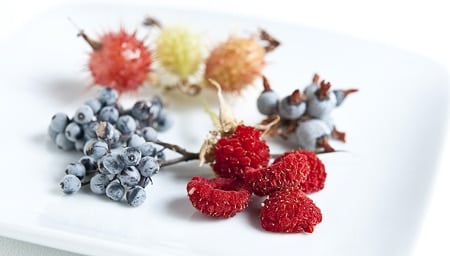
My friend Josh and I recently went up to the Sierra in search of berries. We’d scoped out some Sierra currants and gooseberries earlier this summer, and this was our trip to clean up on these berries. We did, and got a couple of surprises in the process.
High up — 6,500 feet or higher — there are still lots of wildflowers in bloom, and the many permanent mountain springs create little oases of lushness in an otherwise dusty environment. The berries are most often found near these springs. Josh wanted to collect elderberries, which are just now coming on strong up there. Me? I wanted to collect the mysterious Sierra currant and Sierra gooseberry, two fruits I’d never eaten before.
Back in June, we’d found lots of bushes, but they were still in flower.
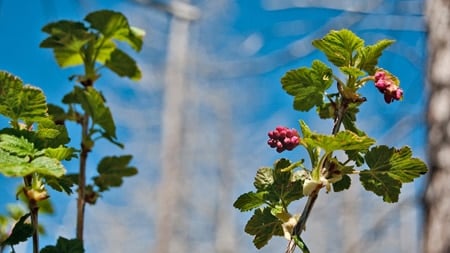
Those pretty magenta flowers ripen into a deep blue currant, distinguishable by a frosty bloom — and the fact that it seems to have five o’clock shadow.
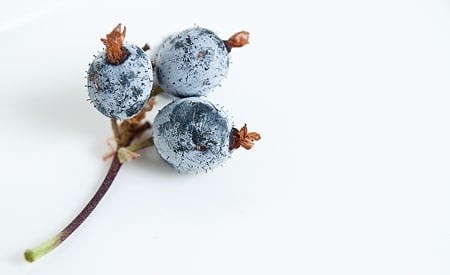
I’d read about these currants, and different authors have different opinions about this berry: Some say they are delicious, others insipid. We tasted some on the bush, and found them,well, OK. Definitely edible, so long as you take the brown corpse of the flower off the end of the berry. A little mealy, no acid to speak of, but reasonably sweet.
All in all, though, the Sierra currant is a dud. I’d happily eat it as a trail nibble, or if I were in trouble, but I will not be picking them again. If you do want to play with these currants, be sure to pick off the dead flower bits first.
Lots of other currant species live in America, however, and I hope to find them soon. There is a Western golden currant out there that is reportedly fantastic — only I’ve never found a single bush. Anyone ever seen one? What about experience with other wild currants? Let me know.
All was not lost, however. Living among those Sierra currants were low-growing Sierra gooseberries. The plants are cousins, and share a very similar leaf — like a ridged, toothed maple leaf. Big difference between currants and gooseberries? Currants grow in clusters on branches with few or no spines. Gooseberries grow singly, and both the fruit and the bushes are spiky. Some more than others.
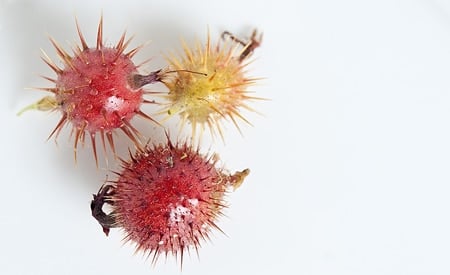
You tough enough to eat these bad boys?
Lemme tell ya, picking these gooseberries absolutely requires leather gloves. Those are real spines that really hurt. What you see in the picture above are the three stages you want to pick gooseberries in: Thinking about getting ripe (note the berry is yellow, not green), almost ripe, and full-on zaftig ripe.
We found some plants laden with the spiky fruit, which I collected with gusto. Just the aroma alone was intoxicating. Sierra gooseberries smell sorta like Sweet Tarts candy. Sharp, fruity and very sweet. Josh and I broke open a couple berries to get at the pulp inside. Delicious! Just the like the domestic gooseberries I used to grow when I lived in Fredericksburg, Virginia.
[on_ad]

But how to deal with those spines. Boy howdy are they nasty! I thought back to the manzanita berries I’d been playing with recently: They were best briefly boiled, crushed with a potato masher and allowed to steep for a long time.
I did the same with the gooseberries. I covered them with water, boiled it for 2-3 minutes, turned off the heat and mashed them with the potato masher. I let the mash cool to room temperature and then poured it into a plastic container to steep in the fridge for several days — you don’t need to wait several days, but I was busy with other things.
I highly recommend you go looking for your native gooseberries — one species or another lives in most every state; I used to collect the Eastern prickly gooseberry when I lived in Minnesota. Once you get them home, if they are too spiny to eat raw, follow these instructions on how to process gooseberries.
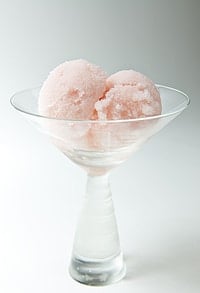
What do you do with gooseberries? I am contemplating making a pie filling from the tan pulp you see at the bottom of the jar; it’s tasty, if unappealing in color. But the pink juice, which is a brilliant scarlet when you use ripe berries, taste like liquid gold. It will need a little sugar to drink straight, or you can make a syrup from the juice by heating it gently with an equal volume of sugar.
Use the syrup on pancakes, over ice cream, or you could make one helluva Bellini by mixing it with sparkling wine.
Or, you could do as I did, and make gooseberry sorbet. Gooseberries have quite a bit of acid to them, so they did not seem right for ice cream. But they were perfect in sorbet — bright, a pretty pale pink, and refreshing.
Flush with gooseberries and elderberries, We drove around looking for other likely places to forage. “What’s that?!” Josh said as we drove by some bushes. I slammed on the brakes and pulled over.
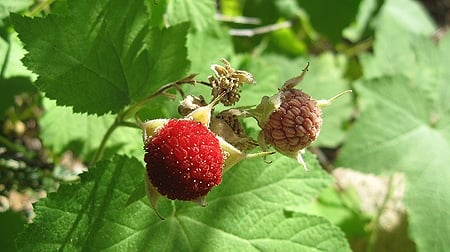
Thimbleberries! Booyah! There is nothing like a thimbleberry. A cousin of the raspberry, it is more delicate, more deeply flavored, more perfect. Raspberry’s beauty is mortal. Thimbleberries are the fruit of Aphrodite.
I picked as many as I could, which is not easy. Thimbleberries are so delicate that they crush with even the slightest pressure. Best bet is to pop off the whole end of the plant so you can ease the berry off its base at home.
Yes, I know people make thimbleberry jam. Or cobbler, or whatever. But sometimes something is so wonderful you want to hide in a corner where no one can see you, popping one berry into your mouth after another — your eyes closing involuntarily — savoring every molecule before it’s gone. Thimbleberries are like that. Eat them plain.
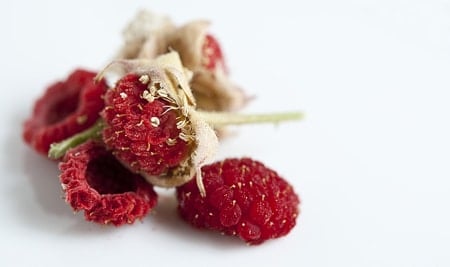
UP NEXT: Out on the Coastal Range. I’m your huckleberry…
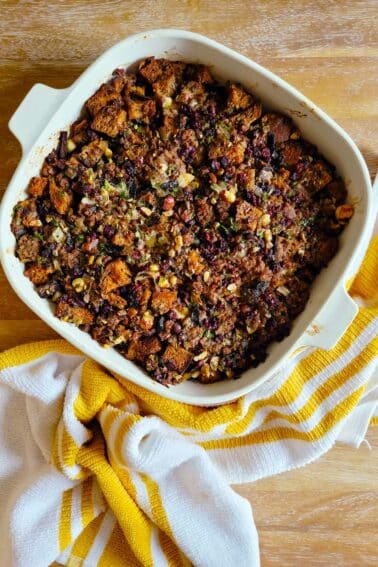
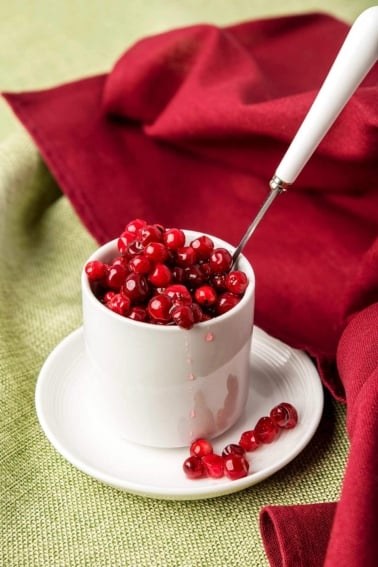


I discover goose berries in the Sierra years ago…, there’s a method of bending the spines in one direction while squeezing the fruit and the inner pulp just pops into your mouth….mmmm….delicious….
Salmonberries grow on California Coastal shady areas that get occasional moisture from fog, north of San Francisco. Large beautiful salmon-colored berries but with very little flavor.
Truly brilliant berry porn!
I love eating thimbleberries, and the northwestern version of gooseberries.
Your post was an inspiration.
In the’30s I worked summers in a logging camp east of Pino Grande (east of Auburn) in the Sierra. I spent lots of spare time picking gooseberries, garefully picking them with thumb and forefinger of each hand, folding the spines back, pricking the fruit with a thumb nail, and squeezing it into my mouth. DELICIOUS. Then the Government created crews to grub out the berries. White Pine Blister Rust (cronartium ribicola)
travels from the current plant to the white pine and kills it. So, no more gooseberries.
I found a large handful of thimble berries in the Sierras outside of Fresno today. Put the whole handful in my mouth at once- what an explosion of flavor. You’ve gotta try it!
Love the post, but loved Holly’s photos even more. Beautiful! Especially loved the shot with all of the berries on the plate.
I had no idea plants like this existed in the Sierra Nevadas. I grew up in Bishop and spent a lot of time around Mammoth Lakes and Lee Vining, but the only edible plants I saw were bitterbrush (super bitter) and pine nuts. Do the berries only grow in certain parts of the mountains? Eek, I think I missed out.
Cool stuff Hank. There are red currants in the sierra as well. A friend made pie and ended up sick. Best he could figure out was alkali poisoning from the seeds. They’re supposed to be edible, but perhaps in moderate doses.
I spent two summers as a fire lookout in the Mt. Hood national forest. I ate gallons and gallons of wild berries every summer. From my experience, you simply can’t beat a thimbleberry for taste. They’re just head and shoulders above every other wild berry I had. To me, they taste like the best raspberries you’ve ever had plus a little cream — somehow.
I agree completely with your sentiment — just eat em. Don’t mess with perfection.
Beautiful pictures, btw.
A huge Oregonian fan,
Bp
Oooh, nice post, and those are some very lovely pictures too.
I notice that the taste of Gooseberries seems to vary quite a bit from from species to species. Around here, I far prefer the the spineless (on the berry at at least, and yes, it’s still a Gooseberry) Ribes leptanthum, both for ease of harvest and quality of taste. They’re far less insipid that the other species of Gooseberries (and our rather blah Wax Currant). Thankfully, they happen to be very common just up the nearest arroyo.
We have Thimbleberry abundantly here in the Gila but unfortunately they rarely seem to produce fruit. I see plenty of flowers, but never even any unripe fruit.
Another wild mountain berry I’m fond of, although its taste might be outside the range of many people’s palates, is Aralia racemosa. They’re traditional in jellies and jams, but seem to have mostly fallen out of favor as far as I know. I love them….not very sweet but flavorful and complex.
And damn, I think I missed the Manzanita berries yet again…
Thats great thank you. If you are down here at some point let me know, we can go get a drink or something and bs.
Victor: Yeah, I sometimes have room/time/space to take newbies. I might be in your neck of the woods again soon, so I will let you know…
Blkdoglady: Great tip on the gooseberries! Will come armed with a fork next time. I did not find chokecherries. Have not yet found a patch in California.
Jen: Never seen a salmonberry this far south; maybe in far northern California. As for salal, well… just wait.
Yeah, the thimbleberries were awesome. And the even better news, I found another spot with many many, many plants! My friend suggested picking them straight into a plastic baggy, then snipping off the tip at the bottom when it’s time to make something out of them.
Wow.
I remember eat thimbleberries as a child (They grow wildly and randomly in my home twon), but I’ve never seen currants or gosseberries in south-western BC. I can’t wait to see what you do with huckleberries though – we always stuck to pancakes.
Out of curiousity, do salmon berries or salal grow as far south as you are?
Thanks, Lanesville Lady! I really enjoyed shooting all the berries from Hank’s outings. They all have such beautiful colors and textures. And flavors too!
Great info. Quick tip – pick the gooseberries with a metal fork. Headed to Sierra’s this weekend and gooseberries are on top of my list, along with the elderberries. Did you find any chokecherries?, they too make a great jam or jelly but require sweetner. Friend made chokecherry wine years ago that was wonderful.
I’m headed to the high country this Friday for a week and am looking forward to doing a little grazing while I’m up there. Glad to hear there are berries this year. Nothing last year.
Beautiful photography Holly.
Great blog Hank.
Hey Holly – super photos! Love the photography in this blog!
Hank, those Thimbleberries look delicious and I would have done what you did – just sit and eat them one by one with my eyes closed relishing each bite!
The list of stuff I want to do now keeps growing, but the time I have to do them gets shorter. More things to go wander around and try to find. Can you also give us more time with your posts more things to do Hank? 🙂 Do you ever have room on your excursions for green peas who want to learn?
Oh amazing. I’ve never seen a thimbleberry in SoCal. Went to pick some hollyleaf cherries a few days ago but they’re inedibly bitter. And looks like the birds got to the currants and gooseberries before me *tears*.
Fantastic post, thank you.